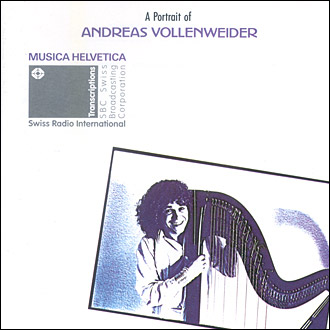A Portrait of Andreas Vollenweider.

Andreas Vollenweider, harp and cheng. Walter Keiser, drums. Pedro Haldemann, percussion. Jon Otis, percussion. Christoph Stiefel, keyboards. Matthias Ziegler, flutes. Max Lässer, guitars. Jörg-Peter "Büdi" Siebert, saxes and flutes.
Portrait of Andreas Vollenweider.
Since the beginnings of the 1980ies Swiss musician Andreas Vollenweider, with his own special variant of the concert harp has become one of the world’s foremost instrumentalists. His music lies somewhere between the classics, pop, rock and jazz. He has created a truly unique brand of music which interweaves strands from various cultures – Wstern, Oriental and Balkan – with natural sound effects such as bird twittering and whales singing.
The origins of the Vollenweider sound.
Andreas Vollenweider plays a normal concert harp with mechanical variations which allow him to combine the soft, almost meditative quality of the instrument with rhythmic, sensous elements. The airy harp music alternates with earthy bass tones.
The harp is supplemented with restrained synthesizer sounds and with various percussion, wind, keyboard and string instruments. To these are added taped effects such as animal noises or the bubbling of water to enable Vollenweider to achieve the “visual” quality he is aiming for.
Vollenweider sees his music not as a “New Age” sound but as a “mind movie”.
Biographical details about Andreas Vollenweider.
Born on 4th october 1953 into a musical family. His father, Hans Vollenweider, is a famous musician and former organist in Zurich Cathedral (presented in “Musica Helvetica MH 6. Prominent Swiss organists”).
Andreas did not quite follow in his father’s footsteps. He had no classical training and strongly believes in selfteaching. Through free improvisation, he gradually learnt the rules of rhythm and harmony without sacrificing his natural spontaneity.
He has become a professional since the age of 15, playing in various jazz and rock groups. Between 1972 and 1978, he was a member of “Poesie und Musik”, a group famous in German-speaking countries for its setting to music of texts by various authors.
Before setting for the harp as his main instrument, Vollenweider played various wind, string and keyboard instruments. His approach to the harp is totally unorthodox. He has integrated bass notes and electric amplification in order to realize his ideas on sound and improvisation. This stylings became an recognizeable factor in his work, even when composing for film, theatre and TV productions.
Between 1981 and 1984, Vollenweider and his fellow musicians, Walter Keiser (drums) and Pedro Haldemann (percussion and “acousticolours”), worked with other guest artists on the trilogy “Behind the Gardens-Behind the Wall-Under the Tree”, (1981), “Caverna Magica (1982) and “White Winds” (1984). A 1987 highlight in his career was his “Grammy Award” for the “Down to the Moon”-album.
Production information.
A Portrait of Andreas Vollenweider (1987). MH CD 68.2. Programme produced by Patrick Linder and Andreas Lüthi for SRI. Music produced by Andreas Vollenweider.

In compliance with the JTI standards
More: SWI swissinfo.ch certified by the Journalism Trust Initiative









You can find an overview of ongoing debates with our journalists here . Please join us!
If you want to start a conversation about a topic raised in this article or want to report factual errors, email us at english@swissinfo.ch.